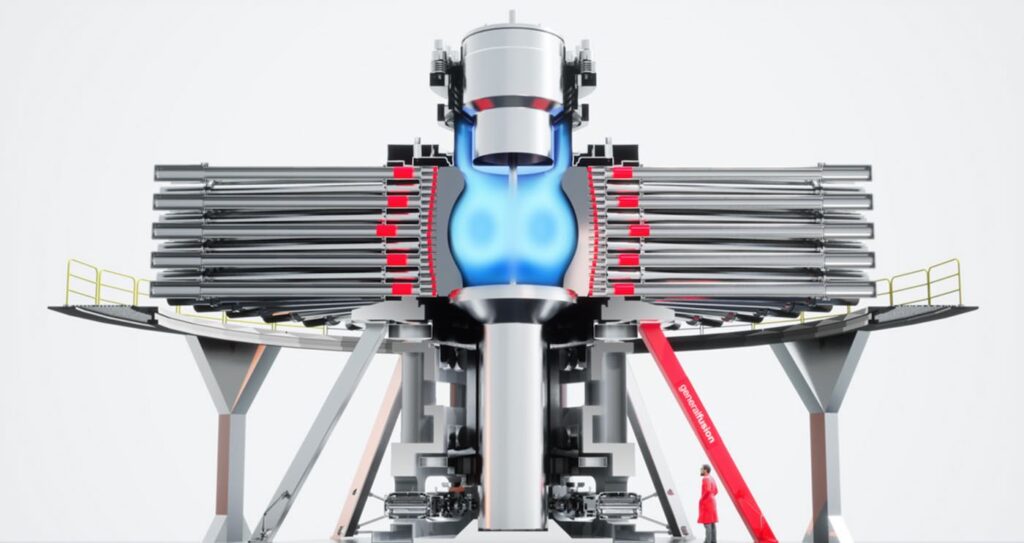
A Canadian nuclear fusion power company has garnered a $400 million investment to build a demonstration energy plant in the UK.
They will showcase their proprietary method for generating electricity through the fusion of hydrogen atoms in the hopes of attracting additional private investors that can kickstart the last great revolution in energy technology.
The fusion plant, illustrated as a glittering cylindrical building of glass and curved hanger-bay doors, will be constructed in Culham, and construction is set to begin next summer in collaboration with the UK’s Atomic Energy Authority.
The Fusion Demonstration Plant will verify that General Fusion’s MTF technology can create fusion conditions in a practical and cost-effective manner at power plant relevant scales, as well as refine the economics of fusion energy production that would lead to a commercial fusion plant.
The Culham demonstration plant would be about 70% the size of a commercial facility.
GNN has reported extensively on nuclear fusion, a process that generates unlimited, clean, on-demand electricity that uses the same process that powers our Sun.
A field that twenty years ago was exclusively the domain of government-funded research has blossomed into a budding private industry rapidly growing in size, variation, and opportunity.
While the Massachusetts-based Commonwealth Fusion Systems uses enormous superconducting magnets and the inter-governmental fusion program called ITER uses magnets as heavy as passenger aircraft and cooled by the world’s largest cryogenic freezer, Canada’s General Fusion company uses much more modest and cheaper existing technology in the form of steam-powered pneumatic pistons.
RELATED: China’s ‘Artificial Sun’ Brings Nuclear Fusion One Step Closer, Breaking World Record
The pistons power the fusion process—creating a magnetic field that causes hydrogen atoms inside a superheated gas known as a plasma to overcome their electromagnetic resistance and fuse together.

The fusion requires temperatures of at least 100 million Celsius, and existing fusion technologies are struggling to find a way to keep the plasma at that temperature for long periods.
For other methods and companies, it’s not a question of “can we generate electricity from fusion,” or even even “can we keep the plasma heated to generate electricity continuously,” but “how can we generate more electricity than we use?”
Ringing out hydrogen
General Fusion has focused on commercializing the technology which, for example, cost ITER over $20 billion for a prototype.
Instead of using magnets to heat and contain the plasma, General Fusion uses a plasma injector—a separate machine—to create a plasma under more economical conditions, and inject it into the fusion reactor’s main chamber.
Inside the chamber is a spinning wall of liquid lithium, which is compressed into a tiny sphere by the pistons. The compression heats the plasma to fusion temperatures, releasing huge amounts of heat, which the liquid metal absorbs easily. It is that heat that is exacted to create steam, which is used to power a turbine, which creates electricity with only helium as the waste product.
“This is incredibly exciting news for not only General Fusion, but also the global effort to develop practical fusion energy,” stated Christofer Mowry, CEO of General Fusion, who predicts the fusion market to be worth $1 trillion in the next decade.
One of the best parts of fusion is it’s completely safe, as there’s no radioactive anything, and helium is the only byproduct. While 100 million Celsius seems dangerous, “if you were to blow on this thing, it just turns itself off,” Dennis Whyte, a Canadian scientist who is director of plasma science fusion center at MIT, explained to the Financial Post.
SEE: How Scientists are Managing to Trap the World’s Coldest Plasma in a Magnetic Bottle
Furthermore, it uses a tiny amount of fuel, and Commonwealth Fusion Systems estimate a cup of something as simple as seawater would generate enough electricity to take care of the power usage of one human for their entire lifetime. Just 70 grams of the hydrogen isotopes deuterium and tritium, which are captured during the fusion reaction is enough to power a small city.
“It’s probably the last energy source we’ll ever tame,” said Whyte. “I think of the trajectory from taming fire and it finally completes in fusion, because we’ll have tamed the energy source of the stars.”
(WATCH the videos for this story below.)
POWER UP the Good News and Get Pals Talking About This Article…




















